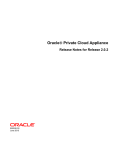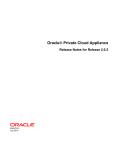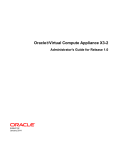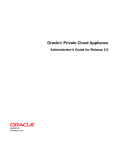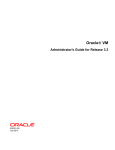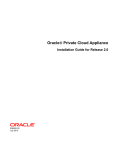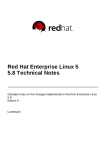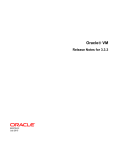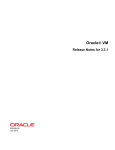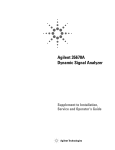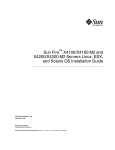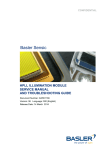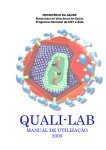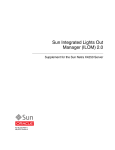Download Oracle® Private Cloud Appliance
Transcript
Oracle® Private Cloud Appliance Release Notes for Release 2.0.1 E56840-03 June 2015 Oracle Legal Notices Copyright © 2013, 2015, Oracle and/or its affiliates. All rights reserved. This software and related documentation are provided under a license agreement containing restrictions on use and disclosure and are protected by intellectual property laws. Except as expressly permitted in your license agreement or allowed by law, you may not use, copy, reproduce, translate, broadcast, modify, license, transmit, distribute, exhibit, perform, publish, or display any part, in any form, or by any means. Reverse engineering, disassembly, or decompilation of this software, unless required by law for interoperability, is prohibited. The information contained herein is subject to change without notice and is not warranted to be error-free. If you find any errors, please report them to us in writing. If this is software or related documentation that is delivered to the U.S. Government or anyone licensing it on behalf of the U.S. Government, then the following notice is applicable: U.S. GOVERNMENT END USERS: Oracle programs, including any operating system, integrated software, any programs installed on the hardware, and/or documentation, delivered to U.S. Government end users are "commercial computer software" pursuant to the applicable Federal Acquisition Regulation and agency-specific supplemental regulations. As such, use, duplication, disclosure, modification, and adaptation of the programs, including any operating system, integrated software, any programs installed on the hardware, and/or documentation, shall be subject to license terms and license restrictions applicable to the programs. No other rights are granted to the U.S. Government. This software or hardware is developed for general use in a variety of information management applications. It is not developed or intended for use in any inherently dangerous applications, including applications that may create a risk of personal injury. If you use this software or hardware in dangerous applications, then you shall be responsible to take all appropriate fail-safe, backup, redundancy, and other measures to ensure its safe use. Oracle Corporation and its affiliates disclaim any liability for any damages caused by use of this software or hardware in dangerous applications. Oracle and Java are registered trademarks of Oracle and/or its affiliates. Other names may be trademarks of their respective owners. Intel and Intel Xeon are trademarks or registered trademarks of Intel Corporation. All SPARC trademarks are used under license and are trademarks or registered trademarks of SPARC International, Inc. AMD, Opteron, the AMD logo, and the AMD Opteron logo are trademarks or registered trademarks of Advanced Micro Devices. UNIX is a registered trademark of The Open Group. This software or hardware and documentation may provide access to or information about content, products, and services from third parties. Oracle Corporation and its affiliates are not responsible for and expressly disclaim all warranties of any kind with respect to third-party content, products, and services unless otherwise set forth in an applicable agreement between you and Oracle. Oracle Corporation and its affiliates will not be responsible for any loss, costs, or damages incurred due to your access to or use of third-party content, products, or services, except as set forth in an applicable agreement between you and Oracle. Documentation Accessibility For information about Oracle's commitment to accessibility, visit the Oracle Accessibility Program website at http://www.oracle.com/pls/topic/lookup?ctx=acc&id=docacc. Access to Oracle Support Oracle customers that have purchased support have access to electronic support through My Oracle Support. For information, visit http://www.oracle.com/pls/topic/lookup?ctx=acc&id=info or visit http://www.oracle.com/pls/topic/lookup?ctx=acc&id=trs if you are hearing impaired. Table of Contents Preface .............................................................................................................................................. v 1 About Oracle Private Cloud Appliance ............................................................................................. 1 1.1 Introduction .......................................................................................................................... 1 1.2 Components ........................................................................................................................ 1 2 Feature Overview ........................................................................................................................... 3 2.1 Changes and Improvements in Release 2.0.1 ........................................................................ 3 2.2 Changes and Improvements in Release 1.1.3 ........................................................................ 4 2.3 Changes and Improvements in Release 1.1.1 ........................................................................ 5 2.4 Changes and Improvements in Release 1.0.2 ........................................................................ 7 2.5 Key Features in Release 1.0.1 ............................................................................................. 8 3 Known Limitations and Workarounds ............................................................................................. 11 3.1 Oracle Private Cloud Appliance Hardware ........................................................................... 11 3.1.1 Compute Node Boot Sequence Interrupted by LSI Bios Battery Error .......................... 11 3.1.2 Management Node Network Interfaces Are Down After System Restart ....................... 11 3.1.3 ILOM Service Processor Clocks Are Out-of-Sync ...................................................... 12 3.2 Oracle Private Cloud Appliance Software ............................................................................ 12 3.2.1 Do Not Reconfigure Network During Compute Node Provisioning or Upgrade .............. 12 3.2.2 Nodes Attempt to Synchronize Time with the Wrong NTP Server ................................ 12 3.2.3 Unknown Symbol Warning during InfiniBand Driver Installation ................................... 13 3.2.4 Node Manager Does Not Show Node Offline Status .................................................. 13 3.2.5 Update Functionality Not Available in Dashboard ...................................................... 13 3.2.6 Interrupting Download of Software Update Leads to Inconsistent Image Version and Leaves Image Mounted and Stored in Temporary Location ................................................ 13 3.2.7 Compute Nodes Lose Oracle VM iSCSI LUNs During Software Update ....................... 14 3.2.8 Virtual Machine File Systems Become Read-Only after Storage Head Failover ............ 14 3.2.9 Oracle VM Manager Tuning Settings Are Lost During Software Update ....................... 14 3.2.10 Oracle VM Manager Fails to Restart after Restoring a Backup Due to Password Mismatch ......................................................................................................................... 14 3.2.11 Oracle VM Java Processes Consume Large Amounts of Resources ......................... 15 3.2.12 External Storage Cannot Be Discovered Over Data Center Network .......................... 15 3.2.13 User Interface Does Not Support Internet Explorer 10 and 11 ................................... 15 3.2.14 Authentication Error Prevents Oracle VM Manager Login ......................................... 16 3.2.15 The CLI Command show Accepts Non-Existent Targets As Parameters .................... 16 3.2.16 The CLI Command diagnose software Fails To Correctly Run Some Diagnostic Tests ............................................................................................................................... 16 4 Feedback and Support .................................................................................................................. 19 4.1 Providing Feedback and Reporting Problems ...................................................................... 19 4.2 Contacting Oracle Specialist Support .................................................................................. 19 4.3 Data Collection for Service and Support .............................................................................. 20 iii iv Preface This document is part of the documentation library for Oracle Private Cloud Appliance (PCA) Release 2.0, which is available at: http://docs.oracle.com/cd/E55813_01. The documentation library consists of the following items: Oracle Private Cloud Appliance Release Notes The release notes provide a summary of the new features, changes, fixed bugs and known issues in Oracle PCA. Oracle Private Cloud Appliance Licensing Information User Manual The licensing information user manual provides information about the various product licenses applicable to the use of Oracle PCA. Oracle Private Cloud Appliance Installation Guide The installation guide provides detailed instructions to prepare the installation site and install Oracle PCA. It also includes the procedures to install additional compute nodes, and to connect and configure external storage components. Oracle Private Cloud Appliance Safety and Compliance Guide The safety and compliance guide is a supplemental guide to the safety aspects of Oracle PCA. It conforms to Compliance Model No. OCA1A. Oracle Private Cloud Appliance Administrator's Guide The administrator's guide provides instructions for using the management software. It is a comprehensive guide to how to configure, monitor and administer Oracle PCA. Oracle Private Cloud Appliance Quick Start Poster The quick start poster provides a step-by-step description of the hardware installation and initial software configuration of Oracle PCA. A printed quick start poster is shipped with each Oracle PCA base rack, and is intended for data center operators and administrators who are new to the product. The quick start poster is also available in the documentation library as an HTML guide, which contains alternate text for ADA 508 compliance. Oracle Private Cloud Appliance Expansion Node Setup Poster The expansion node setup poster provides a step-by-step description of the installation procedure for an Oracle PCA expansion node. A printed expansion node setup poster is shipped with each Oracle PCA expansion node. The expansion node setup poster is also available in the documentation library as an HTML guide, which contains alternate text for ADA 508 compliance. Audience The Oracle Private Cloud Appliance (PCA) documentation is written for technicians, authorized service providers, data center operators and system administrators who want to install, configure and maintain a private cloud environment in order to deploy virtual machines for users. It is assumed that readers have experience installing and troubleshooting hardware, are familiar with web and virtualization technologies and have a general understanding of operating systems such as UNIX (including Linux) and Windows. The Oracle PCA makes use of Oracle Linux and Oracle Solaris operating systems within its component configuration. It is advisable that administrators have experience of these operating systems at the very v Related Documentation least. Oracle PCA is capable of running virtual machines with a variety of operating systems including Oracle Solaris and other UNIXes, Linux and Microsoft Windows. The selection of operating systems deployed in guests on Oracle PCA determines the requirements of your administrative knowledge. Related Documentation Additional Oracle components may be included with Oracle PCA depending on configuration. The documentation for such additional components is available as follows: • Sun Rack II 1042 and 1242 http://docs.oracle.com/cd/E19844-01/index.html • Oracle Server X5-2 http://docs.oracle.com/cd/E41059_01/index.html • Sun Server X4-2 http://docs.oracle.com/cd/E36975_01/index.html • Sun Server X3-2 http://docs.oracle.com/cd/E22368_01/index.html • Oracle ZFS Storage Appliance ZS3-ES http://docs.oracle.com/cd/E37831_01/index.html • Sun ZFS Storage Appliance 7320 http://docs.oracle.com/cd/E28317_01/index.html • Oracle Switch ES1-24 http://docs.oracle.com/cd/E39109_01/index.html • NM2-36P Sun Datacenter InfiniBand Expansion Switch http://docs.oracle.com/cd/E36265_01/index.html • Oracle Fabric Interconnect F1-15 http://docs.oracle.com/cd/E38500_01/index.html • Oracle Integrated Lights Out Manager (ILOM) 3.1 http://docs.oracle.com/cd/E24707_01/index.html • Oracle VM http://docs.oracle.com/cd/E35328_01/index.html Access to Oracle Support Oracle customers have access to electronic support through My Oracle Support. For information, visit http://www.oracle.com/pls/topic/lookup?ctx=acc&id=info or visit http://www.oracle.com/pls/topic/lookup? ctx=acc&id=trs if you are hearing impaired. vi Feedback Feedback Provide feedback about this documentation at: http://www.oracle.com/goto/docfeedback Conventions The following text conventions are used in this document: Convention Meaning boldface Boldface type indicates graphical user interface elements associated with an action, or terms defined in text or the glossary. italic Italic type indicates book titles, emphasis, or placeholder variables for which you supply particular values. monospace Monospace type indicates commands within a paragraph, URLs, code in examples, text that appears on the screen, or text that you enter. Document Revision Document generated on: 2015-06-30 (revision: 761) vii viii Chapter 1 About Oracle Private Cloud Appliance Table of Contents 1.1 Introduction .................................................................................................................................. 1 1.2 Components ................................................................................................................................ 1 This chapter provides a quick overview of the product and its components. 1.1 Introduction Oracle Private Cloud Appliance (PCA) is an Oracle Engineered System designed for virtualization. It is an offering that industry analysts refer to as a Converged Infrastructure Appliance: an infrastructure solution in the form of a hardware appliance that comes from the factory pre-configured. Compute resources, network hardware, storage providers, operating systems and applications are engineered to work together but are managed and operated as a single unit. Installation, configuration, high availability, expansion and upgrading are automated and orchestrated as much as possible. The minimum configuration consists of a base rack with infrastructure components, a pair of management nodes, and two compute nodes. This configuration can be extended by one compute node at a time. All rack units, whether populated or not, are pre-cabled and pre-configured at the factory in order to facilitate the installation of expansion compute nodes on-site at a later time. Within approximately one hour after power-on, the appliance is ready to create virtual servers. Virtual servers are commonly deployed from Oracle VM templates (individual pre-configured VMs) and assemblies (interconnected groups of pre-configured VMs). The primary value proposition of Oracle PCA is the integration of components and resources for the purpose of ease of use and rapid deployment. It should be considered a general purpose solution in the sense that it supports the widest variety of operating systems, including Windows, and any application they might host. Customers can attach their existing storage or provide storage solutions from Oracle or third parties. 1.2 Components The Oracle PCA consists of a Sun Rack II 1242 base, populated with the hardware components identified in Figure 1.1. Note Oracle Private Cloud Appliance base racks are factory installed with Sun Server X4-2 nodes. Earlier versions of the Oracle PCA were shipped with Sun Server X3-2 nodes, but these servers are no longer available although they continue to be supported by the Oracle PCA controller software. Oracle PCA racks that contain Sun Server X3-2 nodes may also contain Sun Server X4-2 nodes if additional nodes have been installed, or existing nodes have been replaced. Software support for Sun Server X4-2 nodes is available as of Release 1.1.3 of the Oracle PCA controller software. The software must be upgraded to Release 1.1.3 or above to support Sun Server X4-2 hardware. Software installed on Oracle PCA racks that are currently being shipped is already at Release 1.1.3 or above. 1 Components Note Earlier versions of the Oracle Private Cloud Appliance were shipped with the Sun ZFS Storage Appliance 7320. This hardware component has since been replaced with the Oracle ZFS Storage Appliance ZS3-ES. Software support for the Oracle ZFS Storage Appliance ZS3-ES is available as of Release 1.1.3. All software releases continue to support the Sun ZFS Storage Appliance 7320. Figure 1.1 Components of an Oracle Private Cloud Appliance Rack Table 1.1 Figure Legend Item Quantity Description A 1 Either Oracle ZFS Storage Appliance ZS3-ES or Sun ZFS Storage Appliance 7320 B 2 Either Sun Server X4-2 or Sun Server X3-2, used as management nodes C 2-25 Either Sun Server X4-2 or Sun Server X3-2, used as virtualization computing nodes D 2 Oracle Fabric Interconnect F1-15 E 2 NM2-36P Sun Datacenter InfiniBand Expansion Switch F 2 Oracle Switch ES1-24 At the software level, Oracle PCA leverages the virtualization technology of Oracle VM and Oracle Virtual Networking. Management, including updates, of the underlying hardware and software is orchestrated and largely automated by the Oracle PCA controller software. 2 Chapter 2 Feature Overview Table of Contents 2.1 2.2 2.3 2.4 2.5 Changes and Changes and Changes and Changes and Key Features Improvements in Improvements in Improvements in Improvements in in Release 1.0.1 Release 2.0.1 ............................................................................... Release 1.1.3 ............................................................................... Release 1.1.1 ............................................................................... Release 1.0.2 ............................................................................... ..................................................................................................... 3 4 5 7 8 This chapter provides an overview of the key features in each release of Oracle Private Cloud Appliance (PCA). 2.1 Changes and Improvements in Release 2.0.1 This section describes functional changes, improvements and bug fixes compared to the previous release. External Storage Support As of this release, Oracle PCA storage can be extended by connecting and configuring external storage hardware. This allows customers to provision virtual machines with virtual disks beyond the capacity of the internal storage, and to provide ample disk space for large repositories and for backup and recovery purposes. The storage hardware is connected to the Fabric Interconnects using either InfiniBand or Fibre Channel technology. For additional information and instructions to extend Oracle PCA storage, refer to the chapter Extending Oracle Private Cloud Appliance - External Storage in the Oracle Private Cloud Appliance Installation Guide. Integrated Command Line Interface Oracle PCA command line utilities are now consolidated into a single command line interface (CLI), which is accessible from the Oracle Linux shell on the management node. The CLI provides both singlecommand and interactive access to all of the tools available in the Oracle PCA Dashboard, as well as many other functions that have no UI equivalent. The design of the CLI makes it possible to script actions that may need to be performed on a regular basis, or to write integration scripts for existing monitoring and maintenance software not directly hosted on the appliance. For details about CLI usage and an overview of the available commands and their options, refer to the chapter The Oracle Private Cloud Appliance Command Line Interface (CLI) in the Oracle Private Cloud Appliance Administrator's Guide. VLAN-Enabled Appliance Management Network The appliance management network now supports the use of VLANs. The IPs you assign to the management node cluster may belong to a VLAN in use at the customer data center. To configure the appliance accordingly, select the VLAN in the Dashboard. The network interfaces of the management nodes are configured to accept VLAN tags. Synchronization Service A synchronization service has been implemented to allow configurable parameters to be set and maintained across heterogeneous sets of components within an Oracle PCA environment. Throughout the life cycle of the appliance, software updates, capacity extensions and configuration changes will occur 3 Provisioning Lock at different points in time. The synchronization service is an extensible foundation for any mechanism implemented to eliminate configuration mismatches. Provisioning Lock The Oracle PCA Dashboard allows administrators to temporarily disable compute node provisioning with the click of a button. When provisioning is suspended, maintenance tasks or management node upgrades can be carried out safely. Bugs Fixed in Release 2.0.1 The following table lists bugs that have been fixed in Oracle PCA Release 2.0.1. Table 2.1 List of Fixed Bugs Bug ID Description 17431002 “Restarting Oracle PCA Service Causes Compute Node Provisioning to Fail” A new mechanism has been implemented to query the internal DHCP database for the availability of IP addresses for a new compute node and its corresponding ILOM. If the Oracle PCA service is stopped, for example with a management node failover, during the provisioning of a compute node, an IP address may have been assigned to an unprovisioned server, and becomes unavailable for future use. Because the appliance provisioning software expects the ILOM to obtain an IP in the same subnet as the compute node, with a value +100 (IPv4 decimal notation) for the final byte, the new DHCP query looks for matching available IPs before assigning them, thereby eliminating the risk of provisioning failing due to mismatches or unavailable IPs. It is still recommended to lock provisioning of new compute nodes during planned failovers such as management node upgrades. 18435883 “Running pca-node-db delete Without Options Deletes All Node Entries from Database” It is no longer possible to delete the contents of the node database this way. 18967069 “Management Node Cluster Configuration Fails During Software Update” During appliance management software upgrade, when the secondary management node takes over the master role, it requires connectivity to the internal storage appliance. New checks now ensure that there is a route to the storage appliance before the software update continues. As a result, the update process will no longer hang because the ovca service is not started when the master role is transferred between management nodes. 2.2 Changes and Improvements in Release 1.1.3 Oracle PCA Release 1.1.3 is a maintenance release. This section describes functional changes, improvements and bug fixes compared to the previous release. OpenSSL Security Upgrade Release 1.1.3 is an errata release that eliminates the OpenSSL security issue CVE-2014-0160 – commonly known as the 'heartbleed bug'. This release of the Oracle PCA software contains an upgraded OpenSSL package that is not affected by the vulnerability in question. 4 Bugs Fixed in Release 1.1.3 Oracle has published an article on Oracle Technology Network to document the current status of its products with respect to OpenSSL security: http://www.oracle.com/technetwork/topics/security/ opensslheartbleedcve-2014-0160-2188454.html Bugs Fixed in Release 1.1.3 The following table lists bugs that have been fixed in Oracle PCA Release 1.1.3. Table 2.2 List of Fixed Bugs Bug ID Description 18553479 “OpenSSL 'Heartbleed' Vulnerability Affects Management Nodes” The patched version of OpenSSL is included in the errata Release 1.1.3 of the Oracle PCA software stack. An upgrade to Release 1.1.3 eliminates the 'heartbleed' vulnerability. 18545030 “OpenSSL upgrade required in Oracle PCA code base” All builds of the Oracle PCA software Release 1.1.3 and later include a version of the OpenSSL package that is not compromised by the 'heartbleed' vulnerability. 2.3 Changes and Improvements in Release 1.1.1 This section describes functional changes, improvements and bug fixes compared to the previous release. Support for Next-Generation Hardware Oracle PCA Release 1.1.1 software adds provisioning and orchestration support for Sun Server X4-2 nodes and the Oracle ZFS Storage Appliance ZS3-ES. Both are standard components in new Release 1.1.1 systems and offer practically the same functionality and performance as their predecessors, but with more up-to-date internal components such as faster CPUs and slightly larger system disks. The new storage appliance uses the exact same disk shelf as the previous model, thus offering the same amount of usable space. Sun Server X4-2 expansion nodes can be installed in Release 1.0.x base racks, provided the software stack is updated to Release 1.1.1 or a future release. Sun Server X4-2 and Sun Server X3-2 compute nodes can be used within the same rack in the same Oracle VM server pool. The only functional implication is that virtual machines cannot be live-migrated between both server types because they belong to separate CPU compatibility groups. In that situation, a virtual machine would need to be shut down on one server and restarted on the other server. Oracle Auto Service Request Oracle PCA is qualified for Oracle Auto Service Request (ASR). ASR is a software feature for support purposes. It is integrated with My Oracle Support and helps resolve problems faster by automatically opening service requests when specific hardware failures occur. Using ASR is optional: the components are available in the Release 1.1.x software image but they must be installed and configured in order to enable ASR for your appliance. Caution Oracle Auto Service Request (ASR) must be installed by an authorized Oracle Field Engineer. Request installation of ASR at the time of system install. Installation at a later date will be a Time and Materials charge. 5 Improved Diagnostics Details about the installation, configuration and usage of ASR can be found in the chapter Automating Oracle Private Cloud Appliance Service Requests of the Oracle Private Cloud Appliance Administrator's Guide. Improved Diagnostics The collection of diagnostic data for troubleshooting has been improved significantly in the Oracle PCA Release 1.1.1 software. Dedicated command line tools are now installed on the management and compute nodes. They collect specific Oracle PCA logs and related files, or Oracle VM troubleshooting data, depending on the selected command line arguments. The health status of each server, its configuration and its main components can be retrieved through the ILOM. The new diagnostic functionality offers customers and field service engineers the same level of troubleshooting capability and serviceability as with other Oracle Engineered Systems. Details about the new diagnostic tools can be found in the section Oracle Private Cloud Appliance Diagnostics Tool of the Oracle Private Cloud Appliance Administrator's Guide. Bugs Fixed in Release 1.1.1 The following table lists bugs that have been fixed in Oracle PCA Release 1.1.1. Table 2.3 List of Fixed Bugs Bug ID Description 17895011 “Backup to storage appliance fails because too many old backups exist” A new mechanism is in place to delete stale, unused backup data after it is exported successfully. It is no longer required to manually clean up the backups on the ZFS storage appliance. 17607389 “Network View tab partially displayed in Internet Explorer” Display issues with the Oracle PCA Dashboard in Internet Explorer 8 and 9 have been resolved. 17192103 “Compute node falls through PXE boot and cannot be provisioned” The Reprovision button in the Dashboard was implemented to recover compute nodes that failed during provisioning. Further enhancements to the reprovisioning functionality now help detect compute nodes in error state and automatically clean up their configuration. Reprovisioning has been made unavailable for correctly provisioned, running compute nodes. 17389234 “Compute node installed but provisioning failed; network not set correctly” The reprovisioning functionality has an improved mechanism to detect the point at which provisioning failed. As a result, it can clean up the compute node configuration in Oracle VM and allow the provisioning to start over. Reprovisioning has been made unavailable for correctly provisioned, running compute nodes. 17430135 “Reprovision button does not work after compute node is discovered in Oracle VM” The reprovisioning functionality can detect compute nodes in error state and automatically clean up their configuration in Oracle VM. Manual clean-up in Oracle VM should no longer be required. Reprovisioning has been made unavailable for correctly provisioned, running compute nodes. 6 Changes and Improvements in Release 1.0.2 2.4 Changes and Improvements in Release 1.0.2 Oracle PCA Release 1.0.2 is a maintenance release. This section describes functional changes, improvements and bug fixes compared to the previous release. Compute Node Provisioning Release 1.0.2 is a mandatory update of the Release 1.0.1 software stack installed during manufacturing. It enables the provisioning of compute nodes once the appliance is installed and updated on-site. A number of enhancements and bug fixes add more robustness and better serviceability of the functionality offered in this release. Bugs Fixed in Release 1.0.2 The following table lists bugs that have been fixed in Oracle PCA Release 1.0.2. Table 2.4 List of Fixed Bugs Bug ID Description 17704931 “Dashboard does not support simultaneous users” Multiple users can now log in to the Dashboard UI simultaneously without issues. 17703144 “Appliance is connected to data center network but external connectivity fails” Both tagged and untagged VLAN traffic is supported for virtual machine networking. Next-level data center switches must be configured accordingly, as described in the section Configuring Data Center Switches for VLAN Traffic of the Oracle Private Cloud Appliance Administrator's Guide. VLAN traffic is not supported for management node external networking. 17626460 “DNS configuration cannot be modified due to field validation error” Field validation has been corrected. DNS entries can be removed from the userconfigurable network settings in the Dashboard UI. 17542460 “Inconsistent password change behavior in Dashboard” Password changes through the Dashboard UI are applied as designed in a reliable and consistent way. 17535669 “Dashboard login screen reports no error for invalid credentials” Error messages are displayed when a user attempts to log in with an incorrect user name or password. 17475229 “Network configuration update is not applied; Dashboard UI provides no feedback” User-configurable network settings are applied as designed in a reliable and consistent way. The Dashboard UI does not reload until the services affected by the configuration changes have restarted. 17457001 “Applying the dummy network configuration from the Quick Start Poster breaks rack connectivity” IP addresses are verified before they are applied. Internally used subnets and reserved addresses are rejected. 17449881 “Choosing Network in Network View causes Java exception” 7 Key Features in Release 1.0.1 Bug ID Description The exception – which had no adverse effects – no longer appears. 17415171 “Virtual machines are assigned to compute nodes in initializing state” Oracle VM does not allow compute nodes to join the server pool before they are completely provisioned and ready to use. If a compute node fails after joining the server pool, Oracle VM is unaware of the failure. This is considered normal behavior and is not harmful to the physical or virtual environment. If the issue is not resolved automatically by Oracle VM and the virtual machine will not start, you can log into Oracle VM Manager and move or migrate the virtual machine to a correctly operating compute node. 17360826 “Updating network configuration fails due to field validation error” Field validation has been corrected for all user-configurable network settings in the Dashboard UI. 17347317 “Backup functionality unavailable in Dashboard” The Backup tab has been removed from the Dashboard UI. Built-in backup functionality is based on a cron job. For more information about backing up your data and recovering after a component failure, user error or full system failure, refer to the Oracle technical white paper entitled Oracle Private Cloud Appliance Backup and Recovery Guide. 17345384 “Restarting management node network service causes Oracle VM server pool to go offline” Manual intervention to restart networking on any node is only necessary in rare situations. This is documented in the section Oracle VM Server Pool Is Offline After Network Services Restart of the Oracle Private Cloud Appliance Administrator's Guide 17315730 “Oracle PCA Dashboard unavailable when logged in to Oracle VM Manager” The order in which you log in to both user interfaces no longer affects their availability. Both may be used side by side. 2.5 Key Features in Release 1.0.1 This section describes the key features offered in Release 1.0.1 of Oracle PCA. Speed and Ease of Use The Oracle PCA is assembled, cabled and pre-installed at the factory, thus eliminating configuration errors and reducing setup time. Administrators are free to focus on transforming the IT infrastructure and delivering flexible services to respond to the organization's requirements. By leveraging the advantages of an integrated system, they save the time normally required for planning and configuring the infrastructure from scratch. Provisioning new applications into flexible virtualized environments, in a fraction of the time required for physical deployments, generates substantial financial benefits. Within approximately one hour after power-on, the appliance is ready to create virtual servers. Automated Deployment With the Oracle PCA, users only need to move the rack into place in the data center, connect power, network and management Ethernet cables, and power on the system. The controller software orchestrates 8 Network Virtualization the installation and configuration of the entire hardware and software environment. At the end of the provisioning process, the user enters the basic configuration properties of the data center environment in the Oracle PCA Dashboard, so that the controller software can prepare the appliance for integration with your existing infrastructure. Compute capacity is extended by adding more compute nodes, one server at a time. The integration of expansion compute nodes is seamless: slide the server into the next available rack unit, connect the cables, and let the controller software discover the new hardware. For a detailed description of provisioning and orchestration, refer to the section Provisioning and Orchestration in the Oracle Private Cloud Appliance Administrator's Guide. Network Virtualization High-performance, low-latency Oracle Fabric Interconnect with Oracle SDN, two products in the Oracle Virtual Networking family, allow automated configuration of the server and storage networks. Oracle SDN dynamically connects servers to networks and storage. It eliminates the physical storage and networking cards found in every server and replaces them with virtual network interface cards (vNICs) and virtual host bus adapters (vHBAs) that can be deployed on the fly. Applications and operating systems see these virtual resources exactly as they would see their physical counterparts. Oracle Virtual Networking simplifies complex data center deployments with a wire-once solution and simple software-defined network configurations. Integrated Storage Oracle PCA features a fully integrated, enterprise-grade Sun ZFS Storage Appliance 7320 for centrally storing the management environment as well as providing data storage for VMs. This storage subsystem is built using Oracle’s enterprise-class storage products and technology and is designed to be fully redundant for maximum fault tolerance and serviceability in production. In addition, each compute node offers extra disk space that can be used as local storage for the virtual infrastructure deployed on it. The storage capacity of Oracle PCA can be expanded beyond the internal, included storage, to external data center racks containing more than one Oracle ZFS Storage Appliance or supported storage available from other storage vendors. High Availability The Oracle PCA is designed for high availability at every level. During the factory installation of Oracle PCA, the two management nodes are configured as a cluster. The cluster relies on an OCFS2 file system exported as a LUN from the ZFS storage to perform the heartbeat function and to store a lock file. The management node that has control over the lock file automatically becomes the master or active node in the cluster. The master management node is always available via the same virtual IP address, thus ensuring continuity of service up to the level of the Dashboard user interface. In case the active management node fails, the cluster detects the failure and the lock is released. Since the standby management node is constantly polling for control over the lock file, it detects when it has control of this file and brings up all the required Oracle PCA services. The management node failover process takes up to 5 minutes to complete. In addition, all configuration databases are stored on the Sun ZFS Storage Appliance 7320, to which components have shared access. The risk of data loss or interruption of service is further reduced by redundant network hardware, clustered storage heads, and a RAID-Z disk configuration that tolerates media failure and automatically detects and corrects bit errors. For more information about high availability, refer to the section High Availability in the Oracle Private Cloud Appliance Administrator's Guide. 9 Templates and Assemblies Templates and Assemblies Within a matter of hours, the system is ready and users can start adding VMs. These can be created from scratch, or deployed from ready-to-run Oracle VM templates and assemblies. As a result, Oracle PCA offers out-of-the-box support for thousands of Oracle and third-party applications. This way, complex Oracle software stacks can be rapidly deployed. The ability to quickly and easily deploy applications to a highly scalable virtualized environment reduces time to market for the business, and allows IT to rapidly deploy and scale test, development, and staging environments. Operating System and Application Support Support for many operating systems and your choice of storage protects your investment and provides easy deployment into your data centers. Getting applications to users requires a lot more than just hardware provisioning. End-users need their applications provisioned as well. Oracle PCA accelerates deployment of the full hardware-to-applications stack so you can get applications to users within hours of power-on, rather than days or weeks. Oracle VM supports up to 128 vCPUs and a variety of guest OSs such as Oracle Linux, Oracle Solaris, and Microsoft Windows. Entire Oracle application stacks can be deployed in minutes to hours using Oracle VM templates and assemblies. By default, all Oracle software that has been certified for use with Oracle VM is certified for Oracle PCA, which includes the Oracle Database, Oracle Fusion Middleware, Oracle Applications, and Oracle Real Application Clusters. 10 Chapter 3 Known Limitations and Workarounds Table of Contents 3.1 Oracle Private Cloud Appliance Hardware ................................................................................... 3.1.1 Compute Node Boot Sequence Interrupted by LSI Bios Battery Error .................................. 3.1.2 Management Node Network Interfaces Are Down After System Restart .............................. 3.1.3 ILOM Service Processor Clocks Are Out-of-Sync .............................................................. 3.2 Oracle Private Cloud Appliance Software .................................................................................... 3.2.1 Do Not Reconfigure Network During Compute Node Provisioning or Upgrade ...................... 3.2.2 Nodes Attempt to Synchronize Time with the Wrong NTP Server ....................................... 3.2.3 Unknown Symbol Warning during InfiniBand Driver Installation ........................................... 3.2.4 Node Manager Does Not Show Node Offline Status .......................................................... 3.2.5 Update Functionality Not Available in Dashboard .............................................................. 3.2.6 Interrupting Download of Software Update Leads to Inconsistent Image Version and Leaves Image Mounted and Stored in Temporary Location ........................................................ 3.2.7 Compute Nodes Lose Oracle VM iSCSI LUNs During Software Update .............................. 3.2.8 Virtual Machine File Systems Become Read-Only after Storage Head Failover .................... 3.2.9 Oracle VM Manager Tuning Settings Are Lost During Software Update ............................... 3.2.10 Oracle VM Manager Fails to Restart after Restoring a Backup Due to Password Mismatch ................................................................................................................................. 3.2.11 Oracle VM Java Processes Consume Large Amounts of Resources ................................. 3.2.12 External Storage Cannot Be Discovered Over Data Center Network ................................. 3.2.13 User Interface Does Not Support Internet Explorer 10 and 11 ........................................... 3.2.14 Authentication Error Prevents Oracle VM Manager Login ................................................. 3.2.15 The CLI Command show Accepts Non-Existent Targets As Parameters ............................ 3.2.16 The CLI Command diagnose software Fails To Correctly Run Some Diagnostic Tests ....................................................................................................................................... 11 11 11 12 12 12 12 13 13 13 13 14 14 14 14 15 15 15 16 16 16 This chapter provides information about the known limitations and workarounds for Oracle Private Cloud Appliance (PCA). 3.1 Oracle Private Cloud Appliance Hardware This section describes hardware-related limitations and workarounds. 3.1.1 Compute Node Boot Sequence Interrupted by LSI Bios Battery Error When a compute note is powered off for an extended period of time, a week or longer, the LSI BIOS may stop because of a battery error, waiting for the user to press a key in order to continue. Workaround: Wait for approximately 10 minutes to confirm that the compute node is stuck in boot. Use the Reprovision button in the Oracle PCA Dashboard to reboot the server and restart the provisioning process. Bug 16985965 3.1.2 Management Node Network Interfaces Are Down After System Restart If the Oracle PCA needs to be powered down and restarted for maintenance or in the event of a power failure, the components should come back up in this order: first networking, then storage, and then the management and compute nodes. For detailed instructions to bring the appliance offline and return it to 11 ILOM Service Processor Clocks Are Out-of-Sync operation, refer to the section Powering Down Oracle Private Cloud Appliance in the Oracle Private Cloud Appliance Administrator's Guide. It may occur that the management nodes complete their boot sequence before the appliance network configuration is up. In that case, the management nodes are unreachable because their bond0 and bond2 interfaces are down. Workaround: Reboot the management nodes again. When they come back online, their network interfaces should be correctly configured. Bug 17648454 3.1.3 ILOM Service Processor Clocks Are Out-of-Sync Most Oracle PCA components are equipped with an Oracle Integrated Lights Out Manager (ILOM). Each ILOM Service Processor (SP) contains its own clock, which is synchronized with the operating system (OS) clock before it leaves the factory. However, when new expansion nodes are installed or when parts in a component have been repaired or replaced, SP clocks could be out-of-sync. The problem may also be the result of a configuration error or normal clock drift. If necessary, the SP clock can be synchronized manually. There is no need to continually update the hardware clock, because it only serves as a reference point for the host OS. Once the systems are up and running the OS obtains the correct time through NTP. Workaround: After configuring the NTP server in the Oracle PCA Dashboard, synchronize the ILOM SPs with the OS clock. The easiest way is to log into the host and run this command: hwclock --systohc. Bug 17664050 3.2 Oracle Private Cloud Appliance Software This section describes software-related limitations and workarounds. 3.2.1 Do Not Reconfigure Network During Compute Node Provisioning or Upgrade In the Oracle PCA Dashboard, the Network Setup tab becomes available when the first compute node has been provisioned successfully. However, when installing and provisioning a new system, you must wait until all nodes have completed the provisioning process before changing the network configuration. Also, when provisioning new nodes at a later time, or when upgrading the environment, do not apply a new network configuration before all operations have completed. Failure to follow these guidelines is likely to leave your environment in an indeterminate state. Workaround: Before reconfiguring the system network settings, make sure that no provisioning or upgrade processes are running. Bug 17475738 3.2.2 Nodes Attempt to Synchronize Time with the Wrong NTP Server External time synchronization, based on ntpd , is left in default configuration at the factory. As a result, NTP does not work when you first power on the Oracle PCA, and you may find messages in system logs similar to these: Oct Oct Oct 1 11:20:33 ovcamn06r1 kernel: o2dlm: Joining domain ovca ( 0 1 ) 2 nodes 1 11:20:53 ovcamn06r1 ntpd_initres[3478]: host name not found:0.rhel.pool.ntp.org 1 11:20:58 ovcamn06r1 ntpd_initres[3478]: host name not found:1.rhel.pool.ntp.org 12 Unknown Symbol Warning during InfiniBand Driver Installation Oct 1 11:21:03 ovcamn06r1 ntpd_initres[3478]: host name not found:2.rhel.pool.ntp.org Workaround: Apply the appropriate network configuration for your data center environment, as described in the section Network Setup in the Oracle Private Cloud Appliance Administrator's Guide. When the data center network configuration is applied successfully, the default values for NTP configuration are overwritten and components will synchronize their clocks with the source you entered. Bug 17548941 3.2.3 Unknown Symbol Warning during InfiniBand Driver Installation Towards the end of the management node install.log file, the following warnings appear: > > > > > > > > > > WARNING: /lib/modules/2.6.39-300.32.1.el6uek.x86_64/kernel/drivers/infiniband/ \ hw/ipath/ib_ipath.ko needs unknown symbol ib_wq WARNING: /lib/modules/2.6.39-300.32.1.el6uek.x86_64/kernel/drivers/infiniband/ \ hw/qib/ib_qib.ko needs unknown symbol ib_wq WARNING: /lib/modules/2.6.39-300.32.1.el6uek.x86_64/kernel/drivers/infiniband/ \ ulp/srp/ib_srp.ko needs unknown symbol ib_wq *** FINISHED INSTALLING PACKAGES *** These warnings have no adverse effects and may be disregarded. Bug 16946511 3.2.4 Node Manager Does Not Show Node Offline Status The role of the Node Manager database is to track the various states a compute node goes through during provisioning. After successful provisioning the database continues to list a node as running, even if it is shut down. For nodes that are fully operational, the server status is tracked by Oracle VM Manager. However, the Oracle PCA Dashboard displays status information from the Node Manager. This may lead to inconsistent information between the Dashboard and Oracle VM Manager, but it is not considered a bug. Workaround: To verify the status of operational compute nodes, use the Oracle VM Manager user interface. Bug 17456373 3.2.5 Update Functionality Not Available in Dashboard The Oracle PCA Dashboard cannot be used to perform an update of the software stack. Workaround: Use the command line tool pca-updater to update the software stack of your Oracle PCA. For details, refer to the section Oracle Private Cloud Appliance Software Update in the Oracle Private Cloud Appliance Administrator's Guide. For step-by-step instructions, refer to the section Update. You can use SSH to log in to each management node and check /etc/pca-info for log entries indicating restarted services and new software revisions. Bug 17476010, 17475976 and 17475845 3.2.6 Interrupting Download of Software Update Leads to Inconsistent Image Version and Leaves Image Mounted and Stored in Temporary Location The first step of the software update process is to download an image file, which is unpacked in a particular location on the ZFS storage appliance. When the download is interrupted, the file system is not cleaned up or rolled back to a previous state. As a result, contents from different versions of the software image 13 Compute Nodes Lose Oracle VM iSCSI LUNs During Software Update may end up in the source location from where the installation files are loaded. In addition, the downloaded *.iso file remains stored in /tmp and is not unmounted. If downloads are frequently started and stopped, this could cause the system to run out of free loop devices to mount the *.iso files, or even to run out of free space. Workaround: The files left behind by previous downloads do not prevent you from running the update procedure again and restarting the download. Download a new software update image. When it completes successfully you can install the new version of the software, as described in the section Update in the Oracle Private Cloud Appliance Administrator's Guide. Bug 18352512 3.2.7 Compute Nodes Lose Oracle VM iSCSI LUNs During Software Update Several iSCSI LUNs, including the essential server pool file system, are mapped on each compute node. When you update the appliance software, it may occur that one or more LUNs are missing on certain compute nodes. In addition, there may be problems with the configuration of the clustered server pool, preventing the existing compute nodes from joining the pool and resuming correct operation after the software update. Workaround: To avoid these software update issues, upgrade all previously provisioned compute nodes by following the procedure described in the section Upgrading Existing Compute Node Configuration from Release 1.0.2 in the Oracle Private Cloud Appliance Administrator's Guide. Bugs 17922555, 18459090, 18433922 and 18397780 3.2.8 Virtual Machine File Systems Become Read-Only after Storage Head Failover When a failover occurs between the storage heads of the Oracle PCA internal ZFS storage appliance, or an externally connected ZFS storage appliance, the file systems used by virtual machines may become read-only, preventing normal VM operation. Compute nodes may also hang or crash as a result. Workaround: There is no documented workaround to prevent the issue. Once the storage head failover has completed, you can reboot the virtual machines to bring them back online in read-write mode. Bugs 19324312 and 19670873 3.2.9 Oracle VM Manager Tuning Settings Are Lost During Software Update During the Oracle PCA software update from Release 1.0.2 to Release 1.1.x, it may occur that the specific tuning settings for Oracle VM Manager are not applied correctly, and that default settings are used instead. Workaround: Verify the Oracle VM Manager tuning settings and re-apply them if necessary. Follow the instructions in the section Verifying and Re-applying Oracle VM Manager Tuning after Software Update in the Oracle Private Cloud Appliance Administrator's Guide. Bug 18477228 3.2.10 Oracle VM Manager Fails to Restart after Restoring a Backup Due to Password Mismatch If you have changed the Oracle PCA password in the Dashboard, and need to restore the Oracle VM Manager from a backup that was made prior to the password change, the passwords will be out of sync, and Oracle VM Manager cannot be started because it cannot connect to its database. In this case, you need to make sure that the actual database password is also restored in the Oracle WebLogic Server 14 Oracle VM Java Processes Consume Large Amounts of Resources JDBC connection configuration used by Oracle VM Manager. It is important to keep the password entries in the Oracle PCA Wallet up-to-date as well, although it is not the cause of this particular bug. Workaround: After restoring the Oracle VM Manager database, also restore the database connection settings for Oracle VM Manager. The Oracle WebLogic Server JDBC connection must be configured to use the password that was in use at the time of the database backup. Make sure that the database entry in the Oracle PCA Wallet matches this password. Caution After synchronizing the passwords to access the Oracle VM Manager MySQL database, restart the ovca service from the master management node command line as follows: service ovca restart. • The database restore procedure is described in the section entitled Restoring the MySQL Database for Oracle VM Manager in the Oracle VM Installation and Upgrade Guide. • The database password used by Oracle VM Manager can be restored by extracting this file from the backup: ovmm/wls/config/jdbc/OVMDS-6373-jdbc.xml. The file must be extracted to this location: /nfs/shared_storage/wls/config/jdbc/OVMDS-6373-jdbc.xml. Since the jdbc directory is symlinked from /u01/app/oracle/ovm-manager-3/machine1/base_adf_domain/ config/jdbc/, the file only needs to be extracted on one of the management nodes. • For instructions to manually update the passwords stored in the Wallet, refer to the section entitled Replacing Default Passwords Manually in the Oracle Private Cloud Appliance Administrator's Guide. Bug 19333583 3.2.11 Oracle VM Java Processes Consume Large Amounts of Resources Particularly in environments with a large number of virtual machines, and when many virtual machine operations – such as start, stop, save, restore or migrate – occur in a short time, the Java processes of Oracle VM may consume a lot of CPU and memory capacity on the master management node. Users will notice the browser and command line interfaces becoming very slow or unresponsive. This behavior is likely caused by a memory leak in the Oracle VM CLI. Workaround: A possible remedy is to restart the Oracle VM CLI from the Oracle Linux shell on the master management node. # /u01/app/oracle/ovm-manager-3/ovm_cli/bin/stopCLIMain.sh # nohup /u01/app/oracle/ovm-manager-3/ovm_cli/bin/startCLIMain.sh& Bug 18965916 3.2.12 External Storage Cannot Be Discovered Over Data Center Network The default compute node configuration does not allow connectivity to additional storage resources in the data center network. Compute nodes are connected to the data center subnet to enable public connectivity for the virtual machines they host, but the compute nodes' physical network interfaces have no IP address in that subnet. Consequently, SAN or file server discovery will fail. Bug 17508885 3.2.13 User Interface Does Not Support Internet Explorer 10 and 11 Oracle PCA Release 2.0.1 uses the Oracle Application Development Framework (ADF) version 11.1.1.2.0 for both the Dashboard and the Oracle VM Manager user interface. This version of ADF does not support Microsoft Internet Explorer 10 or 11. 15 Authentication Error Prevents Oracle VM Manager Login Workaround: Use Internet Explorer 9 or a different web browser; for example Mozilla Firefox. Bug 18791952 3.2.14 Authentication Error Prevents Oracle VM Manager Login In environments with a large number of virtual machines and frequent connections through the VM console of Oracle VM Manager, the browser UI login to Oracle VM Manager may fail with an "unexpected error during login". A restart of the ovmm service is required. Workaround: From the Oracle Linux shell of the master management node, restart the ovmm service by entering the command service ovmm restart. You should now be able to log into Oracle VM Manager again. Bug 19562053 3.2.15 The CLI Command show Accepts Non-Existent Targets As Parameters The CLI command show expects a target parameter to be specified to indicate the target object for which information should be displayed. For most commands you can use tab-completion to determine what target objects are available for use as a parameter. However, if you enter a target object that does not exist, the command completes successfully but does not return any useful information. For example: PCA> show cloud-wwpn blah ---------------------------------------Cloud_Name blah WWPN_List ---------------------------------------Status: Success When using the show rack-layout command on an x4-2 rack, tab-completion may indicate that the rack name is 'x3-2_base'. This is a misnomer for the rack, however the command works as expected. Bug 19679777 3.2.16 The CLI Command diagnose software Fails To Correctly Run Some Diagnostic Tests The CLI command diagnose software executes several individual tests that execute various scripts from the management node where the command is executed. There is a known issue with this mechanism where some of these scripts fail to run due to a missing ssh key. Therefore, it is recommended that this command is not run for diagnostic purposes until this issue has been resolved in a forthcoming release. If required, a workaround is available, which involves exchaning the ssh keys between the live management node and itself. This can be achieved by running the following command on the management node: [root@ovcamn05r1 ~]# ssh-copy-id [email protected] The authenticity of host '192.168.4.3 (192.168.4.3)' can't be established. RSA key fingerprint is 4e:33:d2:d1:2c:43:7f:f1:74:3f:42:b3:83:78:22:78. Are you sure you want to continue connecting (yes/no)? yes Warning: Permanently added '192.168.4.3' (RSA) to the list of known hosts. [email protected]'s password: If you implement this workaround, you should check that you are able to ssh into the managment node from itself, and that /root/.ssh/authorized_keys does not contain any additional keys that you were not expecting to be added. 16 The CLI Command diagnose software Fails To Correctly Run Some Diagnostic Tests Bug 19667855 17 18 Chapter 4 Feedback and Support Table of Contents 4.1 Providing Feedback and Reporting Problems .............................................................................. 19 4.2 Contacting Oracle Specialist Support .......................................................................................... 19 4.3 Data Collection for Service and Support ...................................................................................... 20 This chapter contains information about how to provide feedback and contact support for the Oracle Private Cloud Appliance (PCA) product. Note Customers who use Oracle Auto Service Request (ASR) do not need to submit a service request through My Oracle Support for the specific hardware failure scenarios covered by ASR. For details, refer to the chapter Automating Oracle Private Cloud Appliance Service Requests of the Oracle Private Cloud Appliance Administrator's Guide Caution Oracle Auto Service Request (ASR) must be installed by an authorized Oracle Field Engineer. Request installation of ASR at the time of system install. Installation at a later date will be a Time and Materials charge. 4.1 Providing Feedback and Reporting Problems If you need to report an issue and have an Oracle Premier Support Agreement, you should open a case with Oracle Support at https://support.oracle.com. If you are reporting an issue, please provide the following information where applicable: • Description of the problem, including the situation where the problem occurs, and its impact on your operation. • Machine type, operating system release, browser type and version, locale and product release, including any patches you have applied, and other software that might be affecting the problem. • Detailed steps on the method you have used, to reproduce the problem. • Any error logs or core dumps. 4.2 Contacting Oracle Specialist Support If you have an Oracle Customer Support Identifier (CSI), first try to resolve your issue by using My Oracle Support at https://support.oracle.com. Your Oracle Premier Support CSI does not cover customization support, third-party software support, or third-party hardware support. If you cannot resolve your issue, open a case with the Oracle specialist support team for technical assistance on break/fix production issues. The responding support engineer will need the following information to get started: • Your Oracle Customer Support Identifier. 19 Data Collection for Service and Support • The product you are calling about. • A brief description of the problem you would like assistance with. • Any logs or support data you have, see Section 4.3, “Data Collection for Service and Support” for details. If your CSI is unknown, find the correct Service Center for your country (http://www.oracle.com/us/support/ contact-068555.html), then contact Oracle Services to open a non-technical service request (SR) to get your CSI sorted. Once you have your CSI, you can proceed to open your case through My Oracle Support. 4.3 Data Collection for Service and Support When submitting a Service Request (SR), please include an archive file with the relevant log files and debugging information as listed in this section. This information can be used by Oracle Support to analyze and diagnose system issues. The support data files can be uploaded for further analysis by Oracle Support. Tip Collecting support files involves logging in to the command line on components in your Oracle PCA rack and copying files to a storage location external to the appliance environment, in the data center network. This can only be achieved from a system with access to both the internal appliance management network and the data center network. You can set up a physical or virtual system with those connections, or use the master management node. The most convenient way to collect the necessary files, is to mount the target storage location on the system using nfs, and copy the files using scp with the appropriate login credentials and file path. The command syntax should be similar to this example: # mkdir /mnt/mynfsshare # mount -t nfs storage-host-ip:/path-to-share /mnt/mynfsshare # scp root@component-ip:/path-to-file /mnt/mynfsshare/pca-support-data/ Collecting Oracle Private Cloud Appliance Support Data Warning For more accurate diagnosis of physical server issues, Oracle Support Services require a system memory dump. For this purpose, kdump must be installed and configured on the component under investigation. The entire procedure is described in the support note with Doc ID 1520837.1. By default, kdump is installed on all Oracle PCA compute nodes and configured to write the system memory dump to the ZFS storage appliance at this location: 192.168.4.1:/export/ nfs_repository1/. Caution For diagnostic data collection, Oracle Support Services recommend that the OSWatcher tool be run for an extended period of time. For details about the use of OSWatcher, please consult the support note with Doc ID 580513.1. OSWatcher is installed by default on all Oracle PCA compute nodes. For diagnostic purposes, Oracle Support Services use a tool called pca-diag that automatically collects vital troubleshooting information from your Oracle PCA environment. This tool is part of the Oracle PCA 20 Collecting Oracle Private Cloud Appliance Support Data controller software installed on both management nodes and on all compute nodes. Its capabilities are described in the section “Oracle Private Cloud Appliance Diagnostics Tool” in the Oracle Private Cloud Appliance Administrator's Guide. To collect support data from your system, proceed as follows: 1. Log in to the master management node as root. 2. Run pca-diag with the appropriate command line arguments. Note Oracle Support teams may request that the tool be run in a specific manner as part of an effort to diagnose and resolve reported hardware or software issues. For the most complete set of diagnostic data, run the command with both arguments: pca-diag ilom vmpinfo. • pca-diag ilom Use this command to detect and diagnose potential component hardware and software problems. [root@ovcamn05r1 ~]# pca-diag ilom Oracle Private Cloud Appliance diagnostics tool Gathering Linux information... Gathering system messages... Gathering PCA related files... Gathering OS version information... Gathering host specific information... Gathering PCI information... Gathering SCSI and partition data... Gathering OS process data... Gathering network setup information... Gathering installed packages data... Gathering disk information... Gathering ILOM Service Processor data... this may take a while Generating diagnostics tarball and removing temp directory ============================================================================== Diagnostics completed. The collected data is available in: /tmp/pcadiag_ovcamn05r1_<ID>_<date>_<time>.tar.bz2 ============================================================================== • pca-diag vmpinfo Use this command to detect and diagnose potential problems in the Oracle VM environment. Note To collect diagnostic information for a subset of the Oracle VM Servers in the environment, run the command with an additional servers parameter, as shown in the example below. [root@ovcamn05r1 ~]# pca-diag vmpinfo servers='ovcacn07r1,ovcacn08r1' Oracle Private Cloud Appliance diagnostics tool Gathering Linux information... Gathering system messages... Gathering PCA related files... Gathering OS version information... 21 Uploading Support Data Files Gathering Gathering Gathering Gathering Gathering Gathering Gathering Gathering host specific information... PCI information... SCSI and partition data... OS process data... network setup information... installed packages data... disk information... FRU data and console history. Use ilom option for complete ILOM data. When the vmpinfo3 script is called as a sub-process from pca-diag, the console output continues as follows: Running vmpinfo tool... Gathering files from servers: ovcacn07r1,ovcacn08r1 This process may take some time. The following server(s) will get info collected: [ovcacn07r1,ovcacn08r1] Gathering OVM Model Dump files Gathering sosreport from ovcacn07r1 Gathering sosreport from ovcacn08r1 Gathering OVM Manager Logs Gathering manager sosreport. When all files have been collected, the data is compressed into two tarballs. One is from the pcadiag tool, while vmpinfo3 writes a separate tarball with its own specific data. Compressing VMPinfo3 <date>-<time>. ======================================================================================= Please send /tmp/vmpinfo3-<version>-<date>-<time>.tar.gz to Oracle OVM support ======================================================================================= Generating diagnostics tarball and removing temp directory ============================================================================== Diagnostics completed. The collected data is available in: /tmp/pcadiag_ovcamn05r1_<ID>_<date>_<time>.tar.bz2 ============================================================================== 3. If necessary, run pca-diag, with or without the ilom argument, on some or all compute nodes as well. 4. To allow better analysis of physical server issues, for example hanging, crashing or rebooting, also include the system memory dump file (vmcore). The location of the file is: <kdump-partition-mount-point>/var/ crash/127.0.0.1-<date>-<time>/vmcore. The partition and mount point are defined during kdump configuration. By default, kdump writes to 192.168.4.1:/export/nfs_repository1/. For details, please consult the support note with Doc ID 1520837.1. 5. When required, collect the OSWatcher logs from the compute nodes. The default location is /opt/ osw. For details, please consult the support note with Doc ID 580513.1. 6. Copy all diagnostic files to a location external to the appliance environment. Uploading Support Data Files For support data up to 2 GB, upload the file as part of the Service Request (SR) process in My Oracle Support (MOS). • If you are still in the process of logging the SR, upload the support data in the Upload Files/ Attachments step of the SR. 22 Uploading Support Data Files • If you have already logged the SR and need to upload files afterwards, proceed as follows: 1. Log into MOS and open the Dashboard or Service Request tab. 2. In the Service Request region, click the SR you want to update. 3. In the Update section, select Add Attachment. 4. In the pop-up window, select the file for upload, include any notes, and click Attach File. If uploading the support data with the SR is not an option, or for support data files over 2 GB in size, use the FTPS file upload service from Oracle support at transport.oracle.com. Oracle Support might request that you upload using a different mechanism. 1. Using an FTPS client, for example FileZilla or WinSCP, access the My Oracle Support File Upload Service transport.oracle.com in passive mode. 2. Log in with your Oracle Single Sign-On user name and password. 3. Select the support data file to upload. 4. Select a destination for the file. Use the directory path provided by Oracle Support. Typically, the directory path is constructed as follows: "/upload/issue/<sr_number>/". The use of a SR number ensures that the file is correctly associated with the service request. Write down the full path to the file and the SR number for future reference in communications with Oracle Support. 5. Upload the file. When the upload is complete, a confirmation message is displayed. Note If you prefer to use a command-line client, for example cURL, you typically enter a single command to connect, authenticate and complete the upload. A cURL command will look similar to this example: curl -T <path_to_file> -u "<user>" ftps://transport.oracle.com/ upload/issue/<sr_number>/. For security reasons, it is recommended that you leave the password out of the command and be prompted to enter the password. For detailed information about uploading files to Oracle Support, refer to the support note with Doc ID 1547088.2. 23 24
































